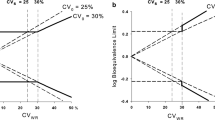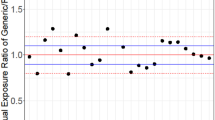Abstract
Introduction
It is widely believed that acceptable bioequivalence studies of drugs with high within-subject pharmacokinetic variability must enroll higher numbers of subjects than studies of drugs with lower variability. We studied the scope of this issue within US generic drug regulatory submissions.
Materials and Methods
We collected data from all in vivo bioequivalence studies reviewed at FDA’s Office of Generic Drugs (OGD) from 2003–2005. We used the ANOVA root mean square error (RMSE) from bioequivalence statistical analyses to estimate within-subject variability. A drug was considered highly variable if its RMSE for C max and/or AUC was ≥0.3. To identify factors contributing to high variability, we evaluated drug substance pharmacokinetic characteristics and drug product dissolution performance.
Results and Discussion
In 2003–2005, the OGD reviewed 1,010 acceptable bioequivalence studies of 180 different drugs, of which 31% (57/180) were highly variable. Of these highly variable drugs, 51%, 10%, and 39% were either consistently, borderline, or inconsistently highly variable, respectively. We observed that most of the consistent and borderline highly variable drugs underwent extensive first pass metabolism. Drug product dissolution variability was high for about half of the inconsistently highly variable drugs. We could not identify factors causing variability for the other half. Studies of highly variable drugs generally used more subjects than studies of lower variability drugs.
Conclusion
About 60% of the highly variable drugs we surveyed were highly variable due to drug substance pharmacokinetic characteristics. For about 20% of the highly variable drugs, it appeared that formulation performance contributed to the high variability.





Similar content being viewed by others
References
L. X. Yu. Bioequivalence of highly variable drugs: issues and challenges. Advisory Committee for Pharmaceutical Sciences Meeting Transcript, April 14, 2004. http://www.fda.gov/ohrms/dockets/ac/04/transcripts/4034T2.pdf (accessed 8/22/07).
Title 21, Code of Federal Regulations. Section 320.1. U.S. Government Printing Office, Washington, D.C., revised 2008.
U.S. Dept. of Health and Human Services, Food and Drug Administration, Center for Drug Evaluation and Research (CDER). Guidance for Industry: Bioavailability and Bioequivalence Studies for Orally Administered Drug Products—General Considerations. March 2003, BP. Revision 1. http://www.fda.gov/cder/guidance/5356fnl.pdf (accessed 8/13/07).
U.S. Dept. of Health and Human Services, Food and Drug Administration, Center for Drug Evaluation and Research (CDER). Guidance for Industry: Statistical Approaches to Establishing Bioequivalence, January 2001, BP. http://www.fda.gov/cder/guidance/3616fnl.pdf (accessed 8/13/07).
C. E. Diliberti. Why bioequivalence of highly variable drugs is an issue. Advisory Committee for Pharmaceutical Sciences Meeting Transcript, April 14, 2004. http://www.fda.gov/ohrms/dockets/ac/04/transcripts/4034T2.pdf (accessed 8/12/07).
K. K. Midha, M. J. Rawson, and J. W. Hubbard. The bioequivalence of highly variable drugs and drug products. Int. J. Clin. Pharmacol. Ther 43:485–498 (2005).
A. A. El-Tahtawy, T. N. Tozer, F. Harrison, L. Lesko, and R. Williams. Evaluation of bioequivalence of highly variable drugs using clinical trial simulations. II: comparison of single and multiple-dose trials using AUC and Cmax. Pharm. Res. 15:98–104 (1998).
L. Tothfalusi, and L. Endrenyi. Limits for the scaled average bioequivalence of highly variable drugs and drug products. Pharm. Res. 20:382–389 (2003).
S. H. Haidar, B. Davit, M. L. Chen, D. Conner, L. M. Lee, Q. H. Li, R. Lionberger, F. Makhlouf, D. Patel, D. J. Schuirmann, and L. X. Yu. Bioequivalence approaches to highly variable drugs and drug products. Pharm. Res. 25:237–241 (2008).
S. H. Haidar. Evaluation of a scaling approach for highly variable drugs. Advisory Committee for Pharmaceutical Sciences Meeting Transcript, October 6, 2006. http://www.fda.gov/ohrms/dockets/ac/06/transcripts/2006–421t2–01.pdf (accessed 8/12/07).
B. M. Davit. Highly variable drugs – bioequivalence issues: FDA proposal under consideration. Advisory Committee for Pharmaceutical Sciences Meeting Transcript, October 6, 2006. http://www.fda.gov/ohrms/dockets/ac/06/transcripts/2006–421t2–01.pdf (accessed 8/12/07).
G. L. Amidon. Sources of variability: physicochemical and gastrointestinal. Advisory Committee for Pharmaceutical Sciences Meeting Transcript, April 14, 2004. http://www.fda.gov/ohrms/dockets/ac/04/transcripts/4034T2.pdf (accessed 8/13/07).
L. Z. Benet. Why highly variable drugs are safer. Advisory Committee for Pharmaceutical Sciences Meeting Transcript, October 6, 2006. http://www.fda.gov/ohrms/dockets/ac/06/transcripts/2006–421t2–01.pdf (accessed 8/12/07).
Acknowledgments
The authors thank LCDR Sheryl D. Gunther, Pharm.D., for her assistance in collecting data for this study.
Author information
Authors and Affiliations
Corresponding author
Additional information
The views expressed in this paper are those of the authors and do not necessarily represent the policy of the Food and Drug Administration.
Rights and permissions
About this article
Cite this article
Davit, B.M., Conner, D.P., Fabian-Fritsch, B. et al. Highly Variable Drugs: Observations from Bioequivalence Data Submitted to the FDA for New Generic Drug Applications. AAPS J 10, 148–156 (2008). https://doi.org/10.1208/s12248-008-9015-x
Received:
Accepted:
Published:
Issue Date:
DOI: https://doi.org/10.1208/s12248-008-9015-x




